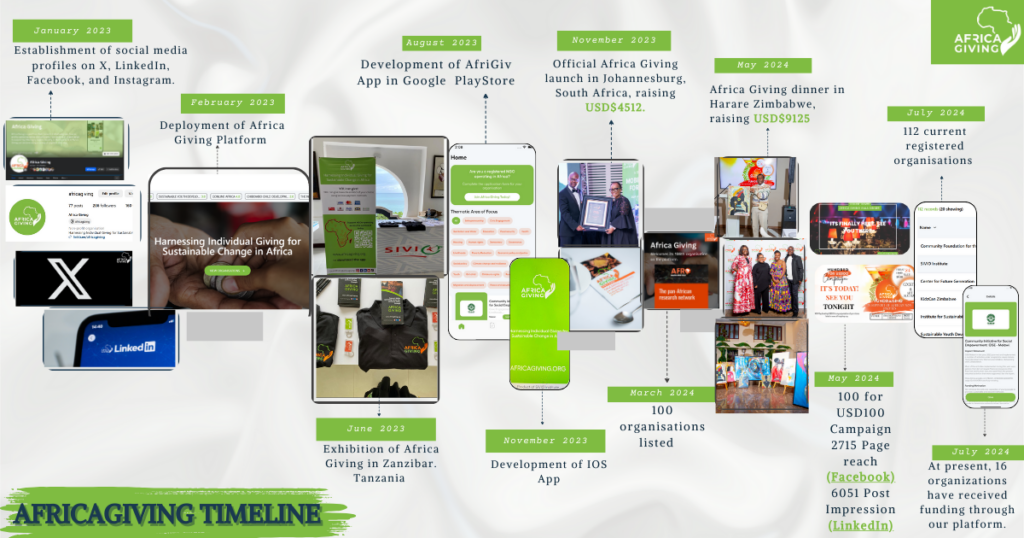Introduction
In 2023 we launched what was perhaps one of our biggest initiatives in the African philanthropy landscape; a platform for giving which we called AfricaGiving. Prior to this, we were mostly known for our work on community foundations in Zimbabwe, some studies on high-net-worth giving and our online Ease of Doing Philanthropy Index which focuses on laws and processes that constrain or promote giving across the Southern Africa Development Community (SADC) region. Our studies, especially of community foundations spread across Zimbabwe, led us to a realisation that (i) the work of these organisations is not widely known beyond their immediate communities, (ii) they are struggling to secure resources to scale their work and (iii) they are not immediately connected with individuals who benefitted from their work in the past (possibly due to beneficiary migration). Furthermore, in the development sector as a whole, there has always been concerns about the extractive nature of research. As researchers we tend to enter communities to harvest data, write our papers and walk away. For us life goes on, but the challenges remain for the affected communities we leave behind. We thought to change that narrative. What if we found a solution to the sustainability challenges that these organisations face? We were not sure what the answer would look like, but we were determined to try.
Learning from the Philanthropy Lab
We experimented with the idea of a Philanthropy Lab. The lab provides a virtual solution for organisational strengthening. Through the lab we provide training and materials to support improved internal governance processes, enhance visibility through a robust communications strategy and use of digital tools, improve financial management and reporting systems. The lab ventured into incorporating elements of fundraising for nonprofits. Recognising the growing need for funders and recipients to connect, we developed an interactive database of funders across thematic and geographic areas. The lab became popular. So popular, It was the most visited digital platform amongst the 17 others on the SIVIO website. However, we had not cracked the funding challenge. All we were doing, like many others, was to point organisations towards funding opportunities. It is important to note that long-term funding opportunities for local non-profits are very rare. In many instances small non-profits are funded as last mile service providers for international NGOs with limited decision-making autonomy on the part of the local organisations. Furthermore, very few have access to institutional funding. Those that engage in local resource mobilisation are constrained by the structural poverty within these communities which limit the size and consistency of support.
Multidimensional Challenges
Fast forward to the idea of building a platform for giving. AfricaGiving was not expected. Through AfricaGiving we were stepping into untested terrain, providing a practical solution for individual giving across Africa. Our aim was and remains to make sure that every local non-profit working across Africa is hosted on the platform and benefits from the services offered on the platform. Everyone else who had come before us- had focused on individual giving within a single country. It made sense. However, Africa is not one country. It is a collection of many countries with many rules and regulations and different currencies too. How do you even conceive of promoting individual giving across different territories, currencies, cultures and language?
The evidence we had collected over the years suggested that there is potential to tap into individual giving. Others (see for instance EPIC Africa’s report) had already found that several organisations depend on individual donors rather than institutional funders. Databases of individual givers were scattered all over. We had also learnt (especially during COVID-19) the importance of mobilizing localized forms of giving as a way of ensuring quick responses.

Selling the Vision and Building Relationships
Armed with all this we went seeking for a digital solution. That was probably the easy part. We had not realized how long it would take to convince organisations to list on this unknown platform . It is perhaps telling that as we write this piece, we only have slightly over 110 organisations listed on the platform. In our initial plan we thought we would have listed at least 1000 organizations by now. We have since learnt to move one step at a time. The majority of the organisations we approached to list were sceptical. Not necessarily of the platform but of the idea of collecting funds from individuals. It was not a part of their usual playbook. Some joined but they were disappointed- they didn’t see the big bucks come in as quickly as they had imagined. Another lesson we and the organisations listed needed to learn, is the need to not just promote the platform but teach potential donors a new culture of giving. Online donations were (and are still) not a common form of giving in African communities.
AfricaGiving is more than just an App. AfricaGiving should perhaps be seen as an infrastructure support platform. We don’t just list organisations. It takes us an average of 7-8 working days to list an organisation on the platform. We must carry out due diligence before each listing. At a minimum we expect the organisation to have a board, strategy, audited financial statements and some sort of an impact statement. We insist on getting to know the organisation- who they are, what they do and their aspirations. The process consists of sending paperwork back and forth. Where the required paperwork does not exist, we take time to support the organisation to formalize. It is a very rewarding process to help an organisation resolve some of its internal processes and an unintended positive impact of improving compliance of listed organisations
The App can probably be seen as just a way of connecting and kickstarting the conversation. AfricaGiving helps build relationships. The first relationship has been between us and the listed organisations. Six months into the work of listing and trying to secure resources we learnt the importance of making sure that listed organisations are equally active in terms of talking about the platform and creating a preliminary list of who would likely fund their work. The individual giving playbook is somewhat different to how institutional funding works. First, there is need to understand why individuals give; secondly a bespoke communications strategy that ensures alignment between what the organisation does relative to motivations for giving; and finally, there is need for accountability to the giver. We have learnt that individual giving is driven by values, especially of empathy, passion around certain causes, familiarity with place and community. Subsequent gifts (after the first) are usually determined by the extent to which the recipient cultivates the relationship with the giver. Our task has been to archive these lessons to all the listed organisations and train (where possible) around the need to shift how communication is done-especially with individual givers. Some of the listed organisations have quickly realized the need to develop a database of givers, promote their page on the platform and join us in our regular activations.
Demonstrating the Potential Impact
We have also realized that in many instances individuals who give are curious to know more about the organisation that they are giving to. New relationships have emerged when these individuals take it upon themselves to recruit their friends and professional associates to support the same cause. Furthermore, we have learnt the need to curate conversations and activations on individual giving. In May 2024, we ran the 100 for $100 campaign via social media platforms. The campaign was aimed at enhancing the visibility of the platform and raising resources for listed organisations. It was a success, raising 93% of US$10 000.11 spotlighted organisations received direct finding from individuals who were moved by their work. Some of the individuals have committed to becoming recurrent givers to organisation they donated to. Among the different organisations we spotlighted were causes that focused on school feeding programs, purchasing of stationary for underprivileged children, reusable sanitary wear training for rural girls to mention but a few. A US$100 translated to meals to 400 meals for children in ECD in a school in Lupane, for others it was 30 reusable pads to be used by 10 girls for 3 months. Indicating what each donation would translate to assisted in building a compelling story for individuals to visualise the potential impact of their contribution. This was an important fundraising tool. The campaign exposed organisations to individual donors whom they ordinarily would have not come into contact with had they not been on Africa Giving. A case in point is donor in Zimbabwe who gave his donation to an organisation in Eswathini. Technology has given us a platform for compelling causes to transcend geographical, language and transactional barriers. In essence the learnings were on the need for continued promotion of the platform around related causes, themes and finally the mindset shifts taking place as we continue engaging with donors and recipients.
Mindsets and Hierarchies
Perhaps, the mindset shift, could be the biggest problem or the proverbial elephant in the room. Despite the growth of Africa’s middle class, individual giving beyond the family remains very limited. In our interactions with would-be givers, we noted challenges to do with conviction, realisation of the need to give and trust. There were limited numbers who were readily convicted to give to charities of their choice. The NGO sector in most parts of Africa has been mistakenly seen as a site of privilege-due to the huge amounts of donor funds. The hierarchies in the NGO sector are not immediately visible to people outside the space. Even more so, the vulnerabilities of local NGOs within that sector are hidden from public view.
Even, when these vulnerabilities are clearly laid out, the solution most people would propose is further strengthening of fundraising from Northern based sources rather than promoting individual giving from local sources. Finally, the would-be recipients of individual gifts are yet to adequately invest in systems and processes that enhance trust. When potential givers do their research, many are left with the impression that their resources are most likely to be abused in these organisations. This is why we emphasise a basic level of compliance and documentation with each listing, to reduce the likelihood of abuse on our platform. Evidently, there is still a long way to go. We have only just begun. We don’t expect immediate windfalls, but we expect attitudes to change, with time.
